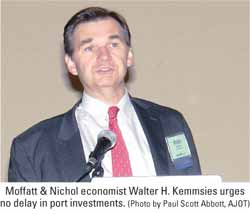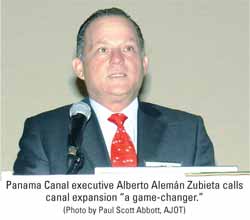By Paul Scott Abbott, AJOT
Florida’s seaports won’t necessarily gain from new direct calls of all-water services transiting an expanded Panama Canal, but they can expect to benefit from increased volumes of cargo transshipped via Caribbean hubs.
Richard A. Wainio, port director and chief executive of the Tampa Port Authority, delivered that message in the closing session of a Jan. 26-27 industry forum co-sponsored by the American Association of Port Authorities and U.S. Maritime Administration and hosted by the Tampa authority.

Wainio, who served 23 years in executive positions with the Panama Canal before its switch from U.S. to Panamanian control as 2000 began, was among dozens of high-level presenters at the third annual Shifting International Trade Routes Workshop, “Examining the Impact of the Panama Canal Expansion.”
“I believe for Florida and some of the southeastern region, and certainly the Gulf ports, transshipment is going to be the bulk of what we see,” Wainio said, referring to impacts of Panama Canal expansion, which is on target for 2014 completion.
While he said he sees some Northeast and mid-Atlantic ports gaining from direct calls from added transcanal services, thus having need for channels deep enough to handle megacontainerships, Wainio said he does not think most ports of Florida – and the Southeast and Gulf regions as a whole – should be pursuing huge investments in deepening harbors when the majority of their new activity will come from transshipment hubs in smaller vessels that their channels already are deep enough to handle. Instead, as is the case in Tampa, the focus should be on expanding landside infrastructure, he said.

Dr. Walter Kemmsies, chief economist for the commercial analysis group of the port engineering firm of Moffatt & Nichol, said ports should not wait until a global economic rebound to move forward with investing in infrastructure.
“Now is the time to make investment decisions, not in a couple of years when things are OK again,” said Kemmsies, whose doctorate is in economics. “If you wait, you’ll be a Johnny B. Lately.”
Orlando Gotay, senior adviser for maritime policy at the U.S. Department of Transportation’s Maritime Administration, vowed an increased federal government role in advancing modernization and expansion of the maritime transportation system and connective infrastructure, commenting, “Change is on the horizon, and expansion of the Panama Canal will bring about a lot of that.”
Alberto Alemán Zubieta, chief executive officer of the Panama Canal Authority, said he sees the canal’s $5.25 billion expansion as “a game-changer.” The expansion – slated to be completed as the water link between Atlantic and Pacific oceans celebrates the 100-year anniversary of its initial opening in 1914 – will allow containerships with capacities of as many as 12,600 twenty-foot-equivalent units to transit and, just as significantly, double its overall annual transit capacity.

Alemán said he believes Panama will become “the main transportation and logistics hub of the Americas,” with major transshipment operations to include Manzanillo and Colón, at the Atlantic/Caribbean opening of the canal.
Robert West, trade and transportation principal with Halcrow Inc., said he believes that, in addition to the Panamanian facilities, transhipment operations could thrive at Kingston, Jamaica; Caucedo, Dominican Republic; Freeport, Bahamas; and Cartagena, Colombia.
However, according to West, Cuba – “the four-letter word that many people haven’t
 Wainio, who served 23 years in executive positions with the Panama Canal before its switch from U.S. to Panamanian control as 2000 began, was among dozens of high-level presenters at the third annual Shifting International Trade Routes Workshop, “Examining the Impact of the Panama Canal Expansion.”
“I believe for Florida and some of the southeastern region, and certainly the Gulf ports, transshipment is going to be the bulk of what we see,” Wainio said, referring to impacts of Panama Canal expansion, which is on target for 2014 completion.
While he said he sees some Northeast and mid-Atlantic ports gaining from direct calls from added transcanal services, thus having need for channels deep enough to handle megacontainerships, Wainio said he does not think most ports of Florida – and the Southeast and Gulf regions as a whole – should be pursuing huge investments in deepening harbors when the majority of their new activity will come from transshipment hubs in smaller vessels that their channels already are deep enough to handle. Instead, as is the case in Tampa, the focus should be on expanding landside infrastructure, he said.
Wainio, who served 23 years in executive positions with the Panama Canal before its switch from U.S. to Panamanian control as 2000 began, was among dozens of high-level presenters at the third annual Shifting International Trade Routes Workshop, “Examining the Impact of the Panama Canal Expansion.”
“I believe for Florida and some of the southeastern region, and certainly the Gulf ports, transshipment is going to be the bulk of what we see,” Wainio said, referring to impacts of Panama Canal expansion, which is on target for 2014 completion.
While he said he sees some Northeast and mid-Atlantic ports gaining from direct calls from added transcanal services, thus having need for channels deep enough to handle megacontainerships, Wainio said he does not think most ports of Florida – and the Southeast and Gulf regions as a whole – should be pursuing huge investments in deepening harbors when the majority of their new activity will come from transshipment hubs in smaller vessels that their channels already are deep enough to handle. Instead, as is the case in Tampa, the focus should be on expanding landside infrastructure, he said.
 Dr. Walter Kemmsies, chief economist for the commercial analysis group of the port engineering firm of Moffatt & Nichol, said ports should not wait until a global economic rebound to move forward with investing in infrastructure.
“Now is the time to make investment decisions, not in a couple of years when things are OK again,” said Kemmsies, whose doctorate is in economics. “If you wait, you’ll be a Johnny B. Lately.”
Orlando Gotay, senior adviser for maritime policy at the U.S. Department of Transportation’s Maritime Administration, vowed an increased federal government role in advancing modernization and expansion of the maritime transportation system and connective infrastructure, commenting, “Change is on the horizon, and expansion of the Panama Canal will bring about a lot of that.”
Alberto Alemán Zubieta, chief executive officer of the Panama Canal Authority, said he sees the canal’s $5.25 billion expansion as “a game-changer.” The expansion – slated to be completed as the water link between Atlantic and Pacific oceans celebrates the 100-year anniversary of its initial opening in 1914 – will allow containerships with capacities of as many as 12,600 twenty-foot-equivalent units to transit and, just as significantly, double its overall annual transit capacity.
Dr. Walter Kemmsies, chief economist for the commercial analysis group of the port engineering firm of Moffatt & Nichol, said ports should not wait until a global economic rebound to move forward with investing in infrastructure.
“Now is the time to make investment decisions, not in a couple of years when things are OK again,” said Kemmsies, whose doctorate is in economics. “If you wait, you’ll be a Johnny B. Lately.”
Orlando Gotay, senior adviser for maritime policy at the U.S. Department of Transportation’s Maritime Administration, vowed an increased federal government role in advancing modernization and expansion of the maritime transportation system and connective infrastructure, commenting, “Change is on the horizon, and expansion of the Panama Canal will bring about a lot of that.”
Alberto Alemán Zubieta, chief executive officer of the Panama Canal Authority, said he sees the canal’s $5.25 billion expansion as “a game-changer.” The expansion – slated to be completed as the water link between Atlantic and Pacific oceans celebrates the 100-year anniversary of its initial opening in 1914 – will allow containerships with capacities of as many as 12,600 twenty-foot-equivalent units to transit and, just as significantly, double its overall annual transit capacity.
 Alemán said he believes Panama will become “the main transportation and logistics hub of the Americas,” with major transshipment operations to include Manzanillo and Colón, at the Atlantic/Caribbean opening of the canal.
Robert West, trade and transportation principal with Halcrow Inc., said he believes that, in addition to the Panamanian facilities, transhipment operations could thrive at Kingston, Jamaica; Caucedo, Dominican Republic; Freeport, Bahamas; and Cartagena, Colombia.
However, according to West, Cuba – “the four-letter word that many people haven’t
Alemán said he believes Panama will become “the main transportation and logistics hub of the Americas,” with major transshipment operations to include Manzanillo and Colón, at the Atlantic/Caribbean opening of the canal.
Robert West, trade and transportation principal with Halcrow Inc., said he believes that, in addition to the Panamanian facilities, transhipment operations could thrive at Kingston, Jamaica; Caucedo, Dominican Republic; Freeport, Bahamas; and Cartagena, Colombia.
However, according to West, Cuba – “the four-letter word that many people haven’t





